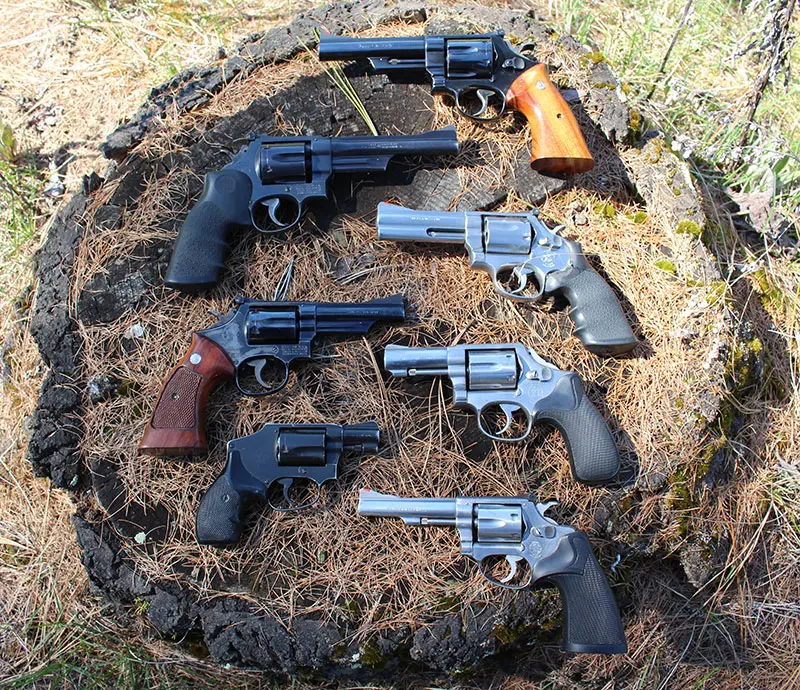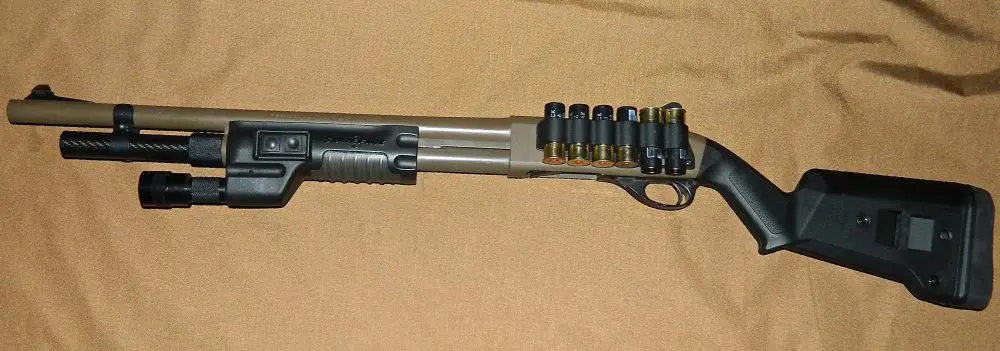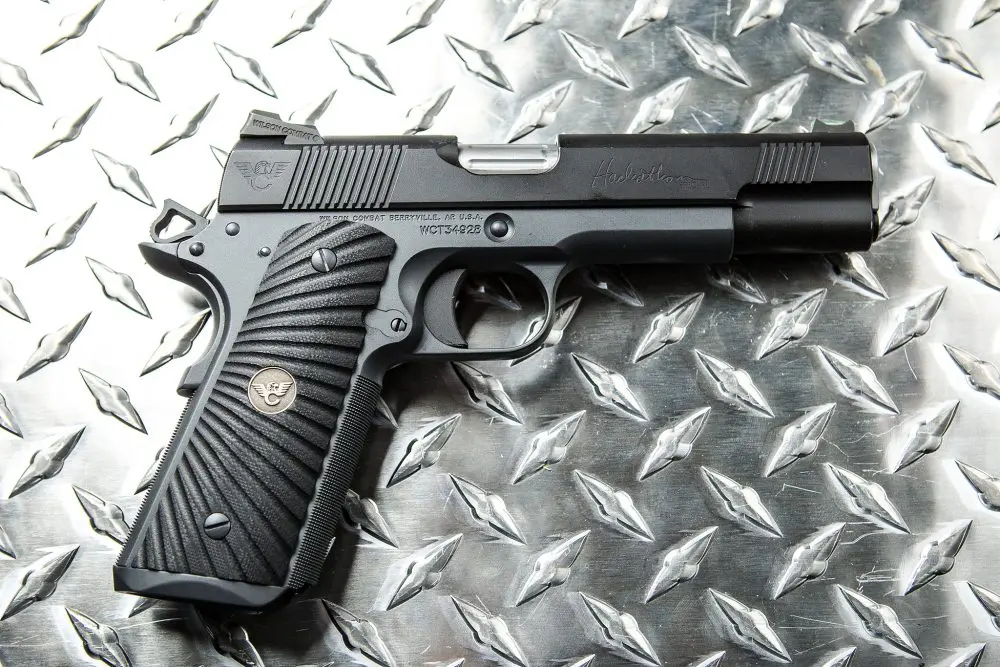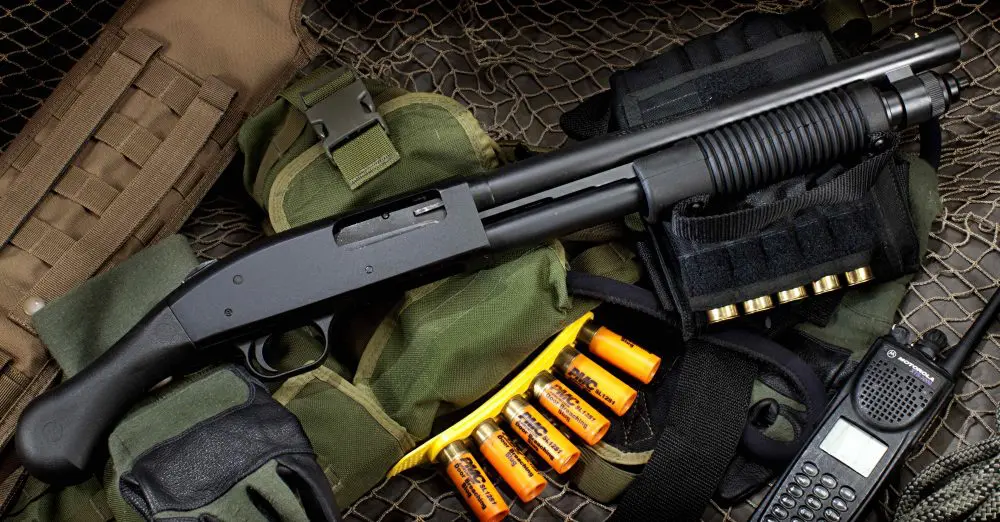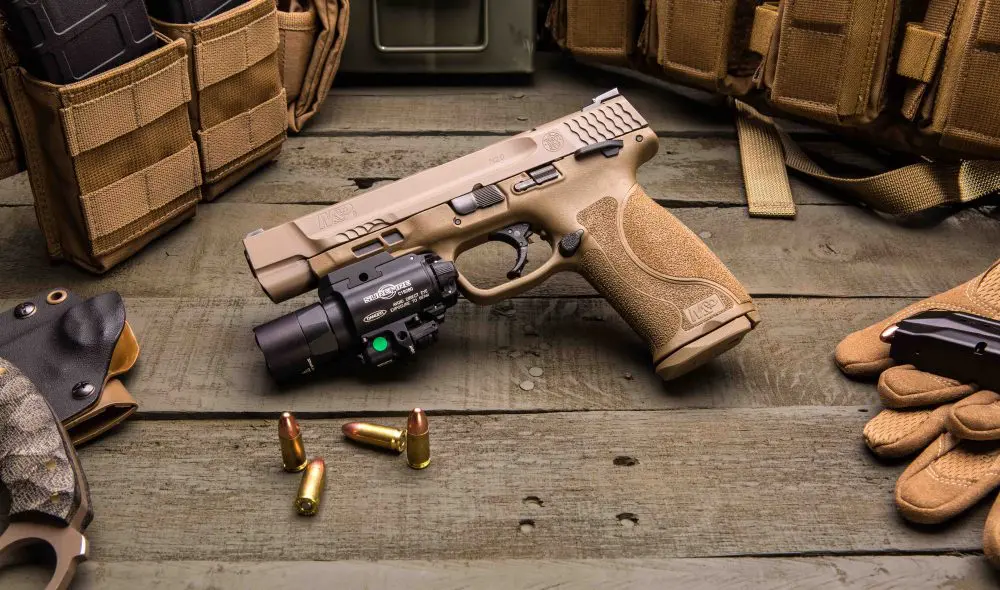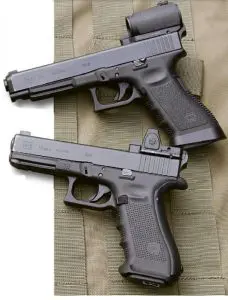
Red Dot Sights (RDS) on pistols have been an undeniable trend over the last few years, and this seems to be accelerating.
When early red dots showed up in IPSC and bullseye competitions, they literally changed the games. They were conspicuously “unserious” and tactical taboo for quite a while, but this changed as certain forward-leaning special-mission units began to experiment and see potential in pistol-mounted RDS.
From there, expansion was rapid and well supported by the industry, with nearly every popular service or competition auto having a pre-milled factory model ready to accept RDS. These factory guns have supplemented the custom slides and gunsmiths who have been busily milling slides. It is into this environment that Raven Concealment Systems has introduced their latest offering—the Balor Red Dot Mount.
The Balor came about at a government customer’s request and is a simple aftermarket addition to a Glock that will mount an RDS—either the Aimpoint T-1 Micro or the Trijicon RMR, with a specific mount for each.
Table of Contents
HOW IT WORKS
The Balor works very simply. The shooter taps out the existing Glock rear sight and removes the slide cover plate. The Balor mounting platform is attached by drifting into the rear sight dovetail. The shooter next installs the replacement slide cover plate and then joins the cover plate to the mounting platform with a screw to ensure the mount stays in place and holds zero.
The shooter then mounts the RMR of his choice (the Aimpoint is attached prior to installation, since the screws run through the bottom of the mount into the optic). It’s kitchen-table simple and doable for even the mechanically challenged.
I’ve installed one of each on Gen 3 and 4 Glocks, and on my samples the fit is superb. The unit slides into the dovetail easily but with good resistance, and literally no air gap is visible between the mount and the top of the slide, even when held to the light.
Making no permanent alterations to the gun, the Balor is an attractive option for many who are interested in the concept but not convinced. Play with the RDS you have for your carbine and don’t cotton to the result? One screw and drift out the mount, and the pistol is back to its previous state. It is also a strong option for those shooting an issue sidearm they can’t take to the machinist to mill a mounting surface into, but who still want a dot.
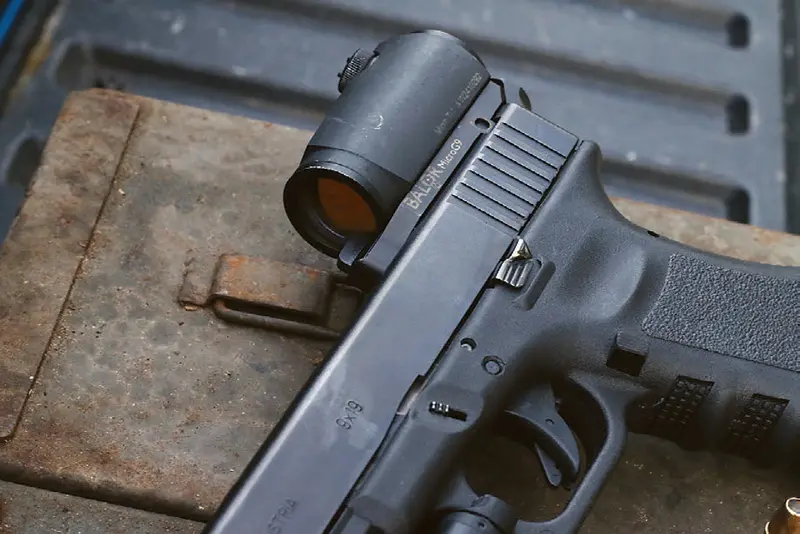
The Balor incorporates a simple steel Glock front sight ahead of the mounting area and uses a notch in the cover plate as a rough alignment for emergency back-up iron sights, since the original front is now on an entirely different plane.
These irons serve two functions. The first is to serve as a guide to help the shooter align the RDS and “find” the dot. The second is to serve as emergency sights in case the dot fails, is turned off, or is too dim for the lighting conditions. The emergency sights did not perfectly regulate for me, but were within a couple of inches at seven yards.
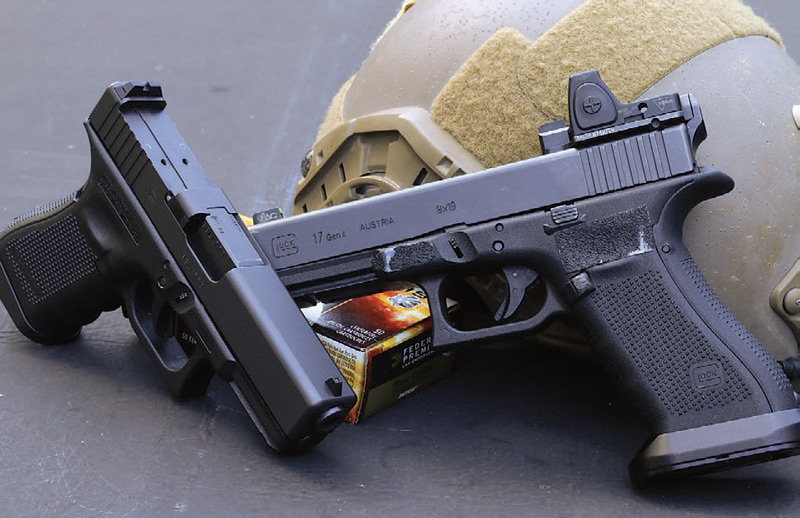
Keep in mind that the “sight radius” they provide is shorter than a North American Arms Mini revolver and significantly less than a J-Frame, so hitting with them past ten yards takes judicious alignment. The Aimpoint gives the additional option of simply shooting through the tube, using it as a giant ghost ring, and that worked quite well for me at seven yards.
The dots mounted solidly on each mount and offered not a hint of wiggle or give. The Aimpoint changes the balance point of the pistol somewhat and the extra ounces also change the recoil impulse noticeably. I haven’t established if the different impulse is “better” or “worse,” but it is different. The Trijicon may have a very slight change in balance for some, but I didn’t notice one, nor a meaningful change to recoil.
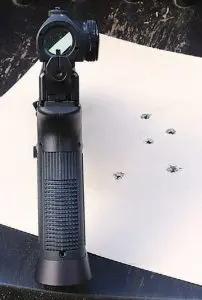
The dots sit higher than the normal sighting plane in the Balor. This allows the shooter to shoot somewhat more erect, but does take away some of the “alignment by feel” aspect for those very accustomed to their irons.
In several cases of Winchester ammo, I haven’t observed any shift in zero—literally none. In fact, there is more shift in most irons (and much more in the awful Glock OEM shiny plastic sights) with normal changes in sunlight direction and angle.
PISTOL RED DOTS: THE GOOD
There are a number of really, really good things about RDS on a pistol.
The aiming process is simplified to “place the dot, press the shot.” There is no alignment to deal with other than putting the dot where a hole needs to be. The visual flicker between target, front, and rear sights that occurs on tough shots is reduced to a pretty flat image of the intended target with a red dot on it. This is especially helpful for shooters whose vision has deteriorated and find a hard front sight focus challenging. I know several shooters who are loud and proud about their love for the RMR on their carry guns for this reason.
The dot is an unrelenting coach. Shooters who have long had a lousy firing grip and wind up their trigger snatch all the way from their toes shoot far better when staring at the little red dot. The dot won’t sit still with a lousy grasp and stance and tends to push shooters into positive self-correction. Ditto the trigger break. A lower mid-level pistolero can easily see the fine trigger finger movement needed to steady the dot while making the gun go off.
The shooter can see more. The iron-sight shooter typically covers up a lot of important stuff with the front and rear sights at distance. It is not hard for the entire point of aim to “disappear” under a fat front sight once the shot gets out past the three point line.
The typical service front sight can cover a 10×12-inch swatch of the target at 50 yards. At that range, even the “large” dots at seven MOA are covering only an index card, and the 3.5 or 4 MOA dots are covering less. This ability to precisely place the dot makes an increasing difference as the shot difficulty or distance ramps up.
Hitting becomes “Wow, I can do that?!” Largely because of the above reasons, the shooter can hit longer and smaller targets with a dot-equipped pistol than they previously thought possible. With both Balor-mounted Glocks, I routinely hit almost “trick shot” type attempts. Both pistols put numerous barricade-supported five-shot groups into seven to eight inches at 100 yards. I had been convinced the Gen 4 17 was average at best in the accuracy department until throwing the RMR on top and cutting my groups by about 20%.
On one occasion, I had a truck-gun scenario set up to test some shotguns and carbines where I was engaging a Defense Targets Steel “A” zone at 40 yards and then a Ready Ship Target (CLANGING STEEL: Renaissance Steel Research Ready Ship Target, January 2017 S.W.A.T.) at 100 yards on the timer. The Balor/Aimpoint-equipped G34 flat embarrassed a Kel-Tec Sub-2000 9mm carbine on that drill. The Kel-Tec has, ahem, mediocre sights and isn’t a great fit for me, so despite being a “rifle,” it couldn’t keep up with the Balor-equipped pistol.
One of my standard truth-tellers is a 3×6-inch steel plate that I typically use at 20 to 25 yards with service autos and try for four out of five hits. Feeling frisky with the T-1 equipped Glock, I set the target at 35 yards. I was pleased, but not overly surprised, to slap the iPhone-sized target with four straight Hornady XTPs.
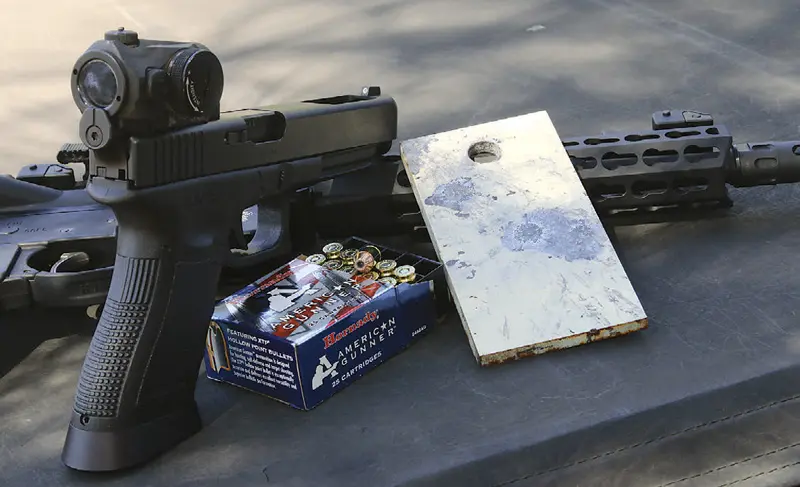
The RDS mounted on the handgun eases manipulation of the slide. It’s like having a giant racking knob on top of the gun. Tactical folk get enthused over ledges on rear sights to aid one-handed manipulation—this is 20 times more surface area.
PISTOL RED DOTS: THE BAD
There is no free lunch. The dots share some issues that must be openly and critically considered before diving in headfirst.
There is an adjustment period to get the “goody” out of the RDS. I suspect this is different for everyone, and skill as well as platform dependent.
For example, for the first 299 rounds, I thought the T-1 was a dud as a pistol tool for anything other than long-range precision. Then on the 300th round, the skies parted, and I received the hidden truths and suddenly was like a whole ‘nother and better shooter. Thereafter I was scorching my standard drills and laying down personal bests.
The RMR took even more acclimation. I found the tube of the T-1 far easier to index and find the dot, while the shape of the RMR was a challenge. Mid tempo and precision drills came online at about 500 rounds, but I didn’t really hit my stride with the RMR until I’d stacked up a bunch of empty Winchester white boxes over numerous range days—about 2,200 rounds.
Close and fast is still an iron-friendly zone. Up close I can beat the dot with low-tech irons. When the shot is simple, I find it easier to track the front sight than to recover the dot. At five yards, I have more “reference” with irons that are in motion and won’t necessarily return to a full proper alignment before I trigger a followup. With an RDS, once the dot leaves the field of view in recoil, I am either point shooting or waiting to get a glimpse of it again.
This condition diminishes with every step farther from the target. At a certain point the two systems are roughly equal; for me this is about seven yards. By ten yards the RDS owns the game. This is a not-insignificant consideration for real-world defensive use. Some shooters are far more likely to use their pistol inside of five yards than others whose mission arena might run to longer shots.
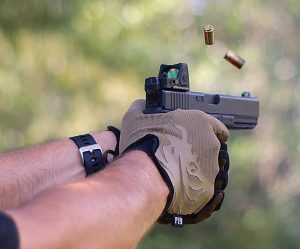
Shooting single-handed was better with the dot but faster with irons. I shot much more accurately and to greater effective ranges with the Balor-equipped pistol when shooting strong- or support-hand only. But inside of ten yards, it was significantly faster to acquire irons and transition to multiple targets.
The dot is rarely at the intensity you want. For me there wasn’t really a Goldilocks setting that gave me precision on super-difficult shots and warp speed up close. The dot was either too bright and blooming out to cover a tiny target, or too dim to pick up confidently at max speed.
This is no sweat in casual shooting, and it’s nice to be able to pump the dot up or down as the shot requires. But it’s worth mentally separating the “either end” performance with a carefully adjusted dot from the “on demand” performance in a general-purpose setting. For many shooters, this will be different. And it’s possible it will still exceed their iron capabilities.
Dot skill atrophies. Speed gained with the RMR in particular was subject to loss without sustainment. The T-1 tube made getting back on the dot after a break pretty simple, whereas the RMR screen took regular sustainment to keep its edge over irons.
Challenges aside, the handgun RDS is here to stay. I have a number of friends who are all in, and more seem poised to jump. The Balor is a great way to try one on.
